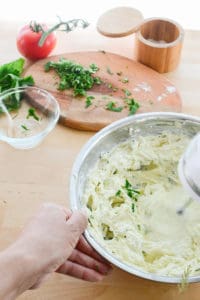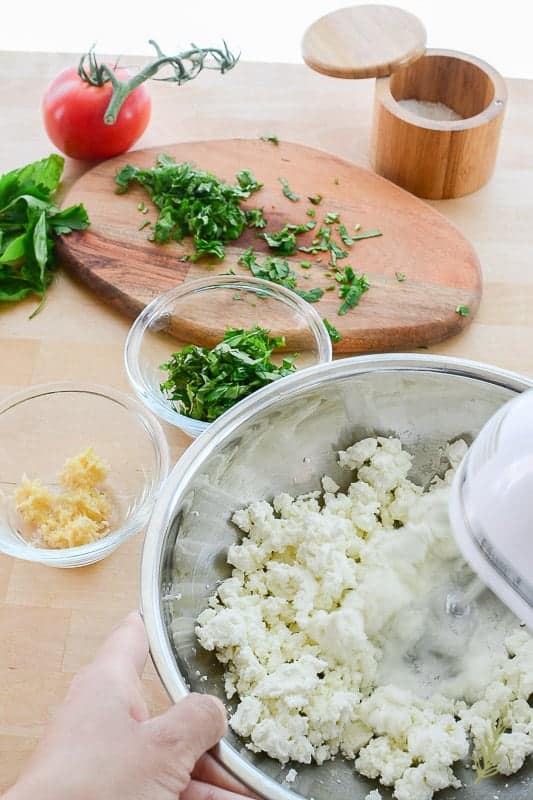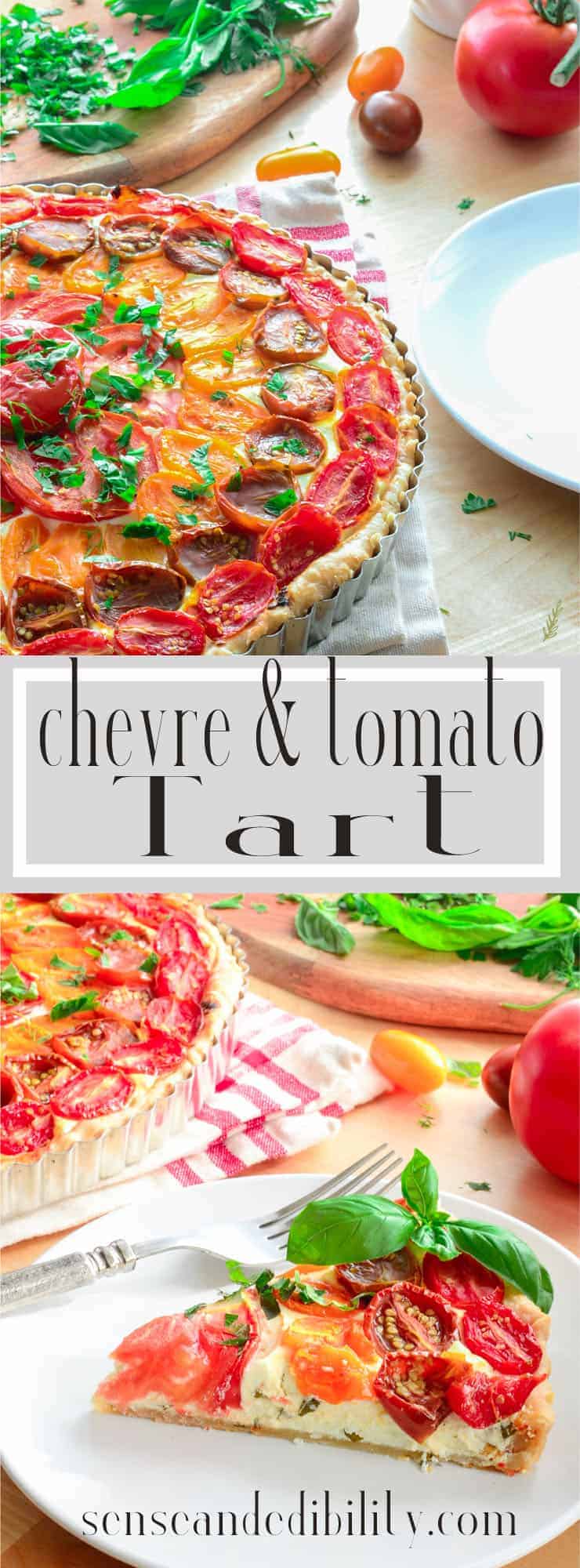
The average temp here in Central Texas has been over 100°F for the past month. Naturally, I have to leave the house- you know, for food and whatnot- and every time I do, I’m slapped in the face with hell. By the time I get back home, the only thing I want to do is die. Okay, that may be a bit dramatic. I want to sleep. That’s better. (But death is a close second)
Days like those make tarts, like this one of chèvre and tomato, the perfect solution for dinner. Especially, if you keep a few discs of pie dough stored away for the dog days of summer like I do. Because of how quickly this tart comes together, and the ease of its preparation, this has become my go-to meal for those “blah” days. And lately there’s been a lot of them. In less than an hour, I can have a rich, hearty main dish to serve with salad, and dinner’s done.
So, what is chèvre? It is, quite simply, French goat cheese. The U.S. has Humboldt Fog, Greece has its feta, Japan has its yogi, and labneh comes from the Eastern Mediterranean. They’re all cheeses made from the milk of goats. While cow’s milk and goat’s milk are very similar in fat content and nutrients, goat’s milk is tangier. As a result, cheese made from goat’s milk, like chèvre pair very well with sweet elements. Hence, the reason why this tart is the perfect balance of sweet and tart.

Of course, I’m not a dictator, so if you have a reservation against using lard, use the shortening. Whatever you do, don’t attempt to make a nice short dough with only butter. Sure, it will taste great, but it also melts easily which leaves you with a gummy dough. That same low melting point extends to the oven where the all-butter dough will begin to melt (possibly shrinking your pie shell), and subsequently burn at faster rate than would an lard-butter dough. Lard has a higher melting and smoke point; it’s the perfect fat to cut with the butter.
Feel free to use leaf lard if pork lard gives too savory a flavor for your liking. The most refined pork lard out there, leaf lard, has a less “porky” flavor (for lack of a more official description). Again, if you have a dietary or religious restriction against using pork products, vegetable shortening is the alternative. Just no straight butter.
Great doughs are cold and stay cold as long as possible. Flakiness comes from the sudden burst of fat melting in a high-heat environment (your oven). The pie crust’s flaky texture is the result of those pockets of empty space. When you bake a dough that has been overworked and under-chilled, you end up with a pie dough that has soft, if not melted, butter worked throughout. The pieces of butter don’t have the opportunity to get shocked into a quick evaporation- i.e., no pockets. No pockets= no flakiness= waah waah pie dough. Taking your time to thoroughly chill your ingredients before, during and right before baking is the key to having the flakiest crust imaginable.
Chilling your butter and lard prior to mixing is essential. I also go so far as to place my measured flour and salt into a metal bowl which I then place in the fridge for a half-hour.








Slice your larger tomatoes into 1/4″ thick slices, and your cherry tomatoes in half.
Place them, cut side up, onto a sheet pan lined with paper towels. Sprinkle a generous amount of kosher salt on to each tomato and cover with another layer of paper towels. Doing this not only extracts the juices from the tomatoes (which allows them to caramelize when they roast), it also flavors the tomatoes. The paper towels, absorb the water that the salt will extract. Allow the tomatoes to sit while you roll out your dough and prepare your chèvre filling.








Chèvre and Tomato Tart
at Sense & EdibilityIngredients
Pie Dough (makes 4 1-crust shells or 2 2-crust shells)
- 1 lb 9oz bread flour
- 2 tsp kosher salt
- 5 oz lard or shortening
- 1 lb cold unsalted butter diced
- 2/3 cup ice water
- 2 medium vine-ripened tomatoes
- 1 pint cherry tomatoes
- 1 pint black zebra cherry tomatoes or preferred variety
- kosher salt to extract tomato juices
Tart Filling
- 20 oz chèvre
- 3 large eggs
- 2 cloves garlic crushed
- 1/2 tsp salt
- pinch freshly ground black pepper
- 1 tbsp fresh basil leaves chopped
- 1/2 tsp fresh mint leaves chopped
- 1 tsp fresh parsley plus more for garnish, chopped
Instructions
- In a large mixing bowl make the pie dough by combining the flour and salt. Cut in the fats using your fingers or a pastry cutter. Add the water (straining the ice out), and mix to hydrate the flour. Once the dough has formed into a non-sticky ball, turn it out onto a lightly floured surface.
- Press flat to create a disc and divide it into four equal portions. Wrap each in plastic wrap and reserve one for now. Refrigerate for at least 30 minutes. You can either refrigerate, or freeze, the remaining pieces for up to two months.
- While your pie dough is chilling, slice your tomatoes into 1/4" thick slices (the cherry tomatoes in half). Place the tomatoes sliced side up on a sheet pan lined with paper towels. Salt liberally to season and extract the excess juice. Cover with another layer of paper towels. Allow to sit for 15-20 minutes.
- Preheat your oven to 350°F. Place a rack on the lower 1/3 of the oven.
- Once your pie dough has chilled for 30 minutes, remove it from the fridge and roll out into a 14" circle. Line your tart pan with the dough. Make sure to press the dough into the pan completely. Dock the shell by poking it with the tines of a fork.
- Line the shell with aluminum foil and fill with ceramic pie weights or dried beans. Bake the shell for 15 mins.
- While your pie shell is baking, begin preparing your chèvre filling. Using a hand held blender, mix together the cheese, eggs (one at a time), garlic, seasonings and herbs, until smooth. Refrigerate until ready to use.
- Remove the shell from the oven and remove the foil and weights. Return the shell to the oven and bake for an additional 15 mins. Take the pan from the oven when baking has finished and allow to cool completely.
- Once your shell has cooled (about 15 minutes), fill it with the chèvre mixture. Arrange the sliced tomatoes in one even layer on top of the filling in a decorative pattern, if desired.
- Bake for 35-40 minutes or until the cheese looks dry around the edges and the tomatoes have taken on some color.
- Remove from the oven and allow to cool for 15-20 minutes before serving. Enjoy!
Notes
Pin this recipe for those days when the weather is trying to kill you. Add these recipes to complete the meal:











“I get slapped in the face with hell” ???????? That’s how I’ve been feeling but I couldn’t adequately describe it until now.
Also, your tart looks delectable ????
LOL!!! It’s SO hot here, Jordan!! WHY!?!?!? (thank you!)